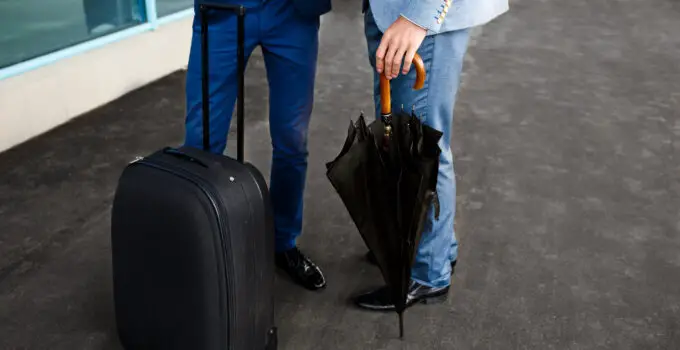Is a camera bag allowed in cabin baggage? This is a common question for photographers and travelers alike. Knowing the rules about carrying valuable gear can save you time and stress at the airport.
Yes, you can bring a camera bag as part of your cabin baggage. Most airlines permit it, but there are size and weight restrictions to consider.
This article breaks down airline policies and offers tips for traveling with camera equipment.
Want to ensure your camera gear travels safely and hassle-free?
Let’s dive into the details of carrying camera bags on flights, and get expert advice from seasoned photographers and travel enthusiasts.
Here can a camera bag be a carry on.
What is cabin baggage?
Cabin baggage, also known as carry-on luggage or hand luggage, refers to the bags and personal items that passengers are allowed to bring with them into the aircraft’s cabin.
This type of baggage is typically stored in the overhead compartments or under the seat in front of the passenger.
Cabin baggage usually includes essentials such as purses, laptops, small backpacks, and briefcases.
Airlines have specific size and weight restrictions for cabin baggage to ensure it can be safely stored and does not obstruct aisles or exits.
The allowances can vary depending on the airline, class of service, and the type of aircraft.
Common items found in cabin baggage include important documents, medications, electronic devices, and any valuable or fragile items that the passenger prefers to keep within reach during the flight.
Carrying essential items in cabin baggage helps ensure they are accessible and secure throughout the journey.
Is camera bag allowed in cabin baggage?
Yes, a camera bag is generally allowed as part of cabin baggage.
Most airlines permit passengers to bring a camera bag on board, either as their main carry-on item or as a personal item, depending on its size.
The camera bag must fit within the airline’s size and weight restrictions for carry-on luggage, which typically vary by airline and class of service.
Passengers often prefer to keep camera equipment in the cabin to ensure its safety and accessibility.
It is advisable to check the specific airline’s policies before traveling, as some may allow a camera bag in addition to the standard carry-on and personal item, while others might count it as one of those items.
To avoid any inconvenience, travelers should ensure that their camera bag is compact and adheres to the airline’s guidelines for carry-on baggage.
Here, are camera bag considered carry on.
This ensures smooth boarding and compliance with safety regulations.
Can i carry camera in cabin baggage?
Yes, you can carry a camera in your cabin baggage. Airlines generally allow passengers to bring cameras, along with other electronic devices, in their carry-on luggage.
This is often preferred by travelers to ensure the safety and security of their valuable equipment.

To carry your camera in the cabin, it should be packed in a bag that meets the airline’s size and weight restrictions for carry-on items.
Many airlines permit a camera bag as part of your standard carry-on allowance or as a personal item. It is essential to check your specific airline’s policies to confirm this.
Keeping your camera in the cabin allows you to have it readily accessible during the flight and protects it from potential damage or theft that could occur in checked baggage.
Ensure your camera bag is well-padded and securely packed to prevent any damage during the journey.
Is photo frame allowed in cabin baggage?
Yes, a photo frame is generally allowed in cabin baggage.
Passengers are permitted to bring personal items such as photo frames in their carry-on luggage, provided the item fits within the airline’s size and weight restrictions for cabin baggage.
When carrying a photo frame, it is advisable to pack it securely to prevent damage during the journey.
If the photo frame is small, it can be easily placed in your carry-on bag or personal item.
For larger photo frames, you may need to check with the airline to ensure it complies with their carry-on size limitations.
Carrying a photo frame in the cabin is beneficial as it allows you to keep delicate and sentimental items with you, reducing the risk of breakage that could occur if they were placed in checked baggage.
Always ensure the frame is well-protected, possibly wrapped in clothing or bubble wrap, to avoid any damage during transit.
Here, can i put my camera in a checked bag?
Can i carry DSLR in cabin baggage?
Yes, you can carry a DSLR camera in your cabin baggage. Airlines generally allow passengers to bring cameras, including DSLRs, in their carry-on luggage.
This practice is often preferred by travelers to ensure the safety and security of their valuable equipment.
To carry your DSLR in the cabin, pack it in a camera bag that fits within the airline’s size and weight restrictions for carry-on items.
Many airlines permit a camera bag as part of your standard carry-on allowance or as a personal item. It’s important to check your specific airline’s policies to confirm this.
Bringing your DSLR in the cabin allows you to have it readily accessible during the flight and protects it from potential damage or theft that could occur in checked baggage.
Ensure your camera bag is well-padded and securely packed to prevent any damage to your equipment during the journey.
Hand carry baggage size for plan?
Hand carry baggage size, also known as carry-on baggage size, varies by airline but generally falls within a similar range.
Most airlines allow carry-on bags with dimensions up to 22 inches (56 cm) in height, 14 inches (36 cm) in width, and 9 inches (23 cm) in depth.
The weight limit for carry-on bags typically ranges from 15 to 22 pounds (7 to 10 kg), although this can vary.
Additionally, airlines often permit a personal item, such as a purse, laptop bag, or small backpack, which should fit under the seat in front of you.
The allowed dimensions for personal items are usually smaller than those for carry-on bags, commonly around 18 x 14 x 8 inches (45 x 35 x 20 cm).
It’s essential to check the specific guidelines of the airline you are flying with, as size and weight restrictions can differ.
Here, how to wear camera shoulder strap.
Adhering to these limits ensures a smooth boarding process and avoids additional fees or the need to check your bag.
TAS requirements
Related faq’s
Can I take a camera bag on a plane?
Yes, you can take a camera bag on a plane.
Most airlines allow passengers to bring a camera bag as part of their cabin baggage, either as the main carry-on item or as a personal item, depending on its size.
The camera bag must fit within the airline’s size and weight restrictions for carry-on luggage, which can vary by airline.
Carrying a camera bag in the cabin is often preferred by travelers to ensure the safety and security of their valuable equipment.
To avoid any issues, it’s important to check the specific airline’s policies regarding carry-on and personal items. Make sure your camera bag is compact and meets the airline’s guidelines.
By keeping your camera bag in the cabin, you have it readily accessible during the flight and can protect it from potential damage or theft that could occur in checked baggage.
Ensure the bag is well-padded and securely packed to prevent any damage during the journey.
Do digital cameras go in hand luggage?
Yes, digital cameras can go in hand luggage. Most airlines allow passengers to carry digital cameras in their carry-on bags, ensuring the safety and security of these valuable items.
Keeping your digital camera in hand luggage protects it from potential damage, loss, or theft that could occur if it were placed in checked baggage.
When packing a digital camera in your hand luggage, ensure it fits within the airline’s size and weight restrictions for carry-on items.
It’s advisable to use a well-padded camera bag to protect your equipment from damage during the flight.
Additionally, keeping your camera in your hand luggage allows you to access it easily if needed during the journey.
Before traveling, check your specific airline’s carry-on policies to ensure compliance and avoid any issues at security checkpoints.
This way, you can travel confidently, knowing your digital camera is safe and secure.
Are camera batteries allowed in hand luggage?
How do you pack a camera bag for travel?
To pack a camera bag for travel, follow these steps:
- Choose the Right Bag: Select a camera bag that fits your gear comfortably, with padded compartments to protect your equipment.
- Organize Your Gear: Place your camera body and lenses in the designated compartments, ensuring each item is secure and won’t shift during travel.
- Protective Accessories: Pack lens filters, lens hoods, and lens caps to protect your lenses. Use lens cloths to keep optics clean.
- Additional Equipment: If carrying a tripod, pack it securely either inside or outside the bag, depending on its size. Include extra batteries, memory cards, chargers, and cables.
- Personal Items: Reserve space for personal items such as a phone, wallet, and travel documents.
- Security Measures: Consider using TSA-approved locks for added security. Keep valuable equipment close to your body during transit.
- Check Airline Policies: Confirm airline policies regarding carry-on size and weight limits for camera bags.
By packing your camera bag methodically and securely, you can travel with peace of mind knowing your equipment is protected and readily accessible.
Are DSLR Camera allowed in carry on bags?
Yes, DSLR cameras are generally allowed in carry-on bags when traveling by air.
Most airlines permit passengers to bring DSLR cameras in their carry-on luggage, either as the main carry-on item or as a personal item, depending on the size of the camera bag and the airline’s policies.
Carrying a DSLR camera in your carry-on bag allows you to keep it safe and accessible during the flight.
It also minimizes the risk of damage or theft compared to checking it in as hold baggage.
To ensure a smooth experience, it’s essential to check the specific airline’s guidelines regarding carry-on baggage size and weight limits.
Additionally, consider using a well-padded camera bag to protect your DSLR camera and lenses during transit.
Following these guidelines helps ensure compliance with airline policies and keeps your camera safe while traveling.








